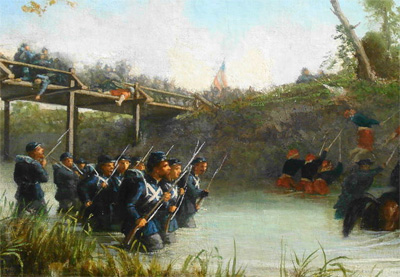Scene & Title Reunited: The Lone Soldier: Homer Battle Scenes

The Lone Soldier: Homer Battle Scenes
Nicolai Cikovsky, Jr. in his essay for the 1988 Homer Civil War exhibition catalog in explaining Homer’s symbolism in the painting The Veteran in a New Field 1865 says, So much did Homer avoid the glorification of the heroic personality, it seems that he more than once depicted its complete opposite (cat.no.7) (2.5).
Cikovsky’s commentary could as easily apply to the situation in which the lone soldier finds himself in this horrific scene. There is no glory, no moment of heroic bravery in this battle scene. The scene depicts the awful reality of war, sudden death without intervention (Fig. 2-4). Leaving this one lone private as the only witness to the shot draws us in as observers and causes us to wonder if he will now shoot the sniper? Firing his weapon while his troop crosses the river may attract the attention of more confederate shooters, making all of his fellow soldier’s easy targets for the enemy. If he does not shoot the rebel shooter now someone else may also die from the sniper’s next shot. The perplexity of this one lone soldier’s impending decision is difficult at best and would weigh heavy on anyone. Many soldiers of the Civil War were young men coming from rural settings. Taking any action would seem to be an insurmountable decision for a simple infantry man. The soldier in Watching the Shot is an iconic image of the much burdened Civil War soldier who saw too much. Nicolai Cikovsky discussing Homers symbolism adds; At virtually the beginning of his artistic career therefore, Homer possessed both the intention and the intelligence to create symbolic meaning (2.6).
Watching the Shot. © 2025 All rights reserved. Terms of Use and Privacy Policy

